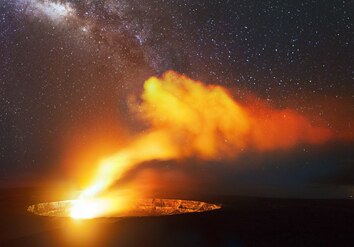Create a free profile to get unlimited access to exclusive videos, sweepstakes, and more!
Holy Kilauea!

I travel quite a bit, and I’m privileged to visit some places of extraordinary beauty. Last week, I returned home from an exceptional trip to the Big Island of Hawaii. The proximal reason for the visit was to attend HawaiiCon, where much fun was had by all.
But as regular readers know, I am a sucker for volcanoes. Despite having been to quite a few, the ones I’ve seen personally are all quiet, either dormant or extinct. That all changed after the con ended, though. My wife and I drove across the island to visit the active volcano Mount Kilauea, and it was nothing short of life-changing.
After spending some time at the ranger station learning about the volcano, we went to the Jaggar Museum on the summit, which had excellent displays about Kilauea. The museum is on the very lip of the gigantic caldera, which is several kilometers across.
While I was there I shot a short video (I apologize for the wind noise; it was pretty gusty up there):
I may have forgotten to mention that I was traveling with my friend Aaron Douglas, aka Chief Tyrol from Battlestar Galactica. He was a guest at HawaiiCon too, and like us wisely decided to stay a few days extra to tour the island with his wife.
Kilauea is active, spewing out a towering plume of sulfur dioxide from a vent in the Halema’uma’u (ha-LAY-mah-oo-mah-oo) crater (which, mind you, is a kilometer across); the plume thankfully was blowing to the southwest when we were there. Here’s what it looked like:
Note how the plume looks blue at the base, and turns brown/red higher up. The blue is from the SO2 molecules in the plume scattering light; blue light hits those molecules and bounces off in random directions. But higher up the plume is seen silhouetted against the sky. The blue light is scattered away, but red light from behind gets through, changing the color of the plume.
In the foreground, on the caldera floor, there were dozens of smaller vents, each blowing out plumes:
I say smaller, but they’re still big compared to puny humans. I was wondering if some of those might have been water vapor plumes, but then through my telephoto lens I saw this one:
The yellow color makes it pretty clear that’s sulfur depositing on the ground. Incredible.
Not far from the crater, just down the trail, is the Kilauea Iki crater, which formed in a huge towering fountain of lava in 1959. Video of that eruption is jaw-dropping. The cinder cone formed all those decades ago still looks as fresh as the day it was violently born:
To give you a sense of scale, the arrow points to a person walking toward the cone along the trail.
We went back to the museum after that and decided to stick around until it got dark. That, it turns out, was one of the best decisions I’ve ever made in my life.
There is a pool of lava at the bottom of the Halema’uma’u, well below view from the crater rim. It also glows too faintly to see during the day, but once the Sun is down, magic happens:
That’s the plume illuminated by the molten rock below. We sat, watching as the sky darkened and the plume grew in brightness, until it glowed a brilliant red in one of the most astonishing sights I have ever witnessed. Short time exposures show it best:
You can see the steep walls of the crater there, and the plume billowing out. As extraordinary as that was, it was the wide view that had me gasping out loud:
This 30-second exposure shows the crater and plume, but also the stars of Scorpius high above. Hawaii is at a latitude of about 20° north of the Equator, which is much farther south than I’m used to. Scorpius was high in the sky, Sagittarius right behind it, and the Milky Way spilled across the sky easily seen to the eye. I couldn’t capture it to my satisfaction, but happily, and coincidentally, the wonderfully gifted astrophotographer Rogelio Bernal Andreo just posted a photo he took of the sky over Kilauea in June, and graciously gave me permission to use it here:
Holy Haleakala! You absolutely must click that to see it in all its beauty. I’ll note Andreo has a book coming out with his photos of Hawaii. It’s already on my holiday wish list.
Seeing this volcano myself was one of the most moving events I have experienced. The sheer power of it is almost overwhelming, the devastation it can cause always foremost on my mind. And yet, amidst all that, there was life, and not just life, but incredibly beautiful life:
We saw these orchids everywhere, along with many other scrappy plants and animals. Volcanoes literally create land, and the rich mix of ingredients in their output is like a smorgasbord to the life there. Kilauea is several hundred thousand years old, and yet is one of the youngest of the volcanoes in Hawaii. The sense of age looming all around you while there provides a perspective I couldn’t hope to appreciate without standing at that spot, sensing it for myself, taking it all in.
So my thanks to the people at HawaiiCon, to the Big Island Visitors Bureau (especially Erin Kinoshita who was tremendously helpful), to Aaron … and also to nature, for providing me a glimpse into its magnificence.


























